A look at IoT technology and the first layers of the IoT technology stack: endpoints and devices (including sensors and actuators), IoT gateways (and device management) and IoT platforms.
The Internet of Things (IoT) consists of several technological layers which all play a role in the route from simply connecting ‘things’ and devices to building applications that serve a clear goal, whether it’s for consumer applications (CIoT), enterprise IoT, connected communities such as smart cities, specific use cases in vertical industries or Industrial IoT projects as we know them from Industry 4.0, to mention some examples.
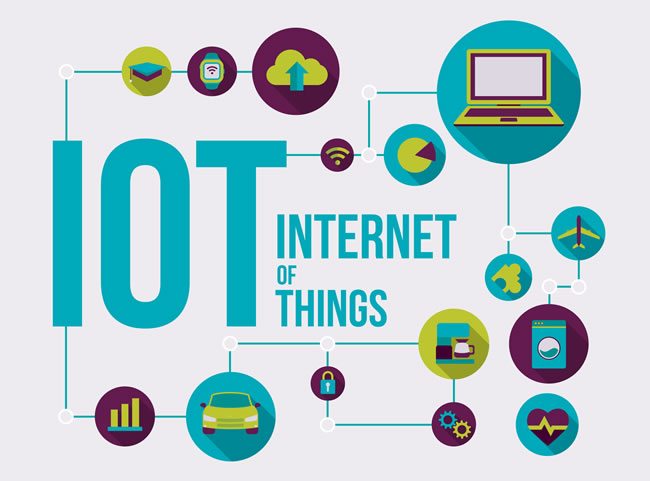
IoT technology should really be IoT technologies as there are several of course and the ones that matter depend on the goal. However, they fit in this IoT technology stack that has various layers, starting with IoT devices, and myriad technologies per layer. Moreover, IoT solutions typically leverage other technologies such as cloud computing, edge computing, artificial intelligence (AI), etc.
In this article we take a first look at the IoT technology stack and especially at the first three layers of that IoT technology stack.
- The first is the IoT device level; as without accurate sensors, actuators and IoT devices in general, no accurate data and without accurate data no Internet of Things, let alone IoT projects or products/services.
- The second is the IoT gateway, which we covered more in-depth but deserves a spot as a layer and certainly in an overview of the IoT device layer with which it is strongly connected and for which is a necessary level towards the next steps of actionable data and business applications or consumer apps and services.
- The third is the IoT platform layer where we connect with the business and consumer applications and services, as well as the development of these services and the management and interconnection with the first two layers.
IoT bridges the gap between the physical world and the digital world and that starts with things.
There are several IoT devices in a broader sense. Some sit at the edge of the network where the real connecting of things happens.
Others include IoT gateways which enable to actually do something with all the data coming from ‘IoT-enabled’ things or connected objects. However, we won’t count IoT gateways as IoT devices as some do; it’s a different IoT technology layer and not even necessarily hardware as we’ll see.
What is IoT technology? The IoT technology stack
The IoT technology stack is nothing else than a range of technologies, standards and tools, which lead from the simple connection of objects to the applications that use these connected things, the data they gather and communicate and the different steps needed to power them.
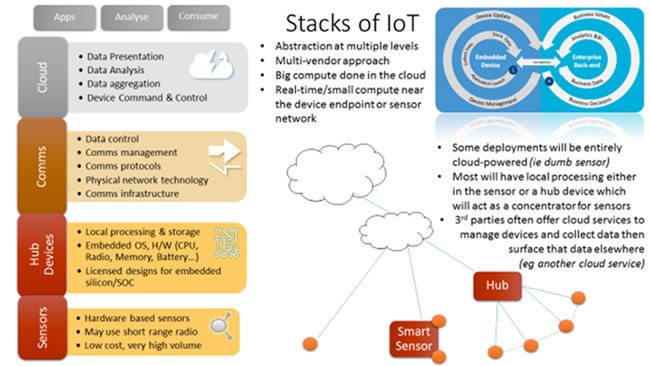
Without that IoT technology stack there would be no possibility to do something with IoT devices and no reason to connect things to the Internet. So, simply said the IoT technology stack encompasses all the needed technologies to move from IoT device and data to an actual purpose and goal or so-called IoT use case.
Yet, although it looks simple, the different layers consist of several technologies and options for an IoT project.
Moreover, it is not just a matter of combining the right technologies across the IoT technology stack but also about doing so in an accurate, secure and cost-effective way.
And in practice there are still quite some challenges on the level of interoperability and all these technology elements being able to talk with each other as there are different standards. Moreover, when we bring in existing connected devices as they’ve existed for ages in areas such as building management or manufacturing technologies, that latter challenge becomes even bigger.
Let’s look at the first layer of the IoT technology stack: IoT devices or IoT endpoints. Do note that there have been various attempts to depict and construct the IoT technology stack (and within each of the layers various protocols, vendors/players and sub-layers). When Cisco still talked about the Internet of Everything (IoE) it also had an IoE technology stack which was more built from that IoE vision (you can see an example in this article on IoT in retail).
Others have focused a lot on the IoT technology stack by comparing with many existing network models such as OSI and TCP/IP. That is for a separate article.
IoT devices and connected physical things
So, the things, the devices, the sensors and so forth are the first IoT technology stack layer. An IoT device can take many forms and shapes.
IoT devices include transducers such as sensors and actuators and myriad objects which are often called ‘smart’, ‘intelligent’ or plain old ‘connected’ (smart light bulbs, connected valves and pumps, smart meters, connected cars, intelligent or smart building components, smart home devices etc.).
When people speak about an IoT device they don’t think about sensors nor actuators nor all the other stuff involved, such as boards, processors/chips, transceivers, micro-electro-mechanical systems or anything like that.
They do think about smart devices such as the ones mentioned or about wearables, intelligent street lighting, activity trackers, smart room controls, smart thermostats, irrigation controllers or maybe about collaborative robots, smart manufacturing assets, health monitoring devices (including in the body), pets or private assets which are tagged with location detection technology and, yes, the good old connected fridge. The list is endless once you start adding agriculture and farming, ‘heavy’ industry, retail, ‘smart’ digital signage and so on.
A connected object can have a few or many thousands of sensors and transducers. A telematics box as is used in cars for car insurance typically has a few sensors, an oil rig can have tens of thousands. Let’s take a deeper look at sensors, actuators and IoT-connected ‘things’.
Do note that, given the fact with IoT devices we are essentially talking about capturing and communicating data, there is also a communications component: that of device connectivity whereby the physical things and controllers get connected through communication and processing units.
Some add this as a separate layer to the IoT technology stack but it does overlap – partially – with the layer of IoT gateways and the layer of IoT connectivity and IoT communication networks which we tackle as a separate IoT layer (not in this article though).
IoT devices: sensors
Sensors exist since long before the IoT in its current meaning and are ubiquitous in, for example, smart buildings, factories, energy and much more.
In all these cases sensors are part of the digital data backbone of connected and intelligent solutions. Anything ‘smart’ and IoT-related is built upon sensors and other types of transducers we’ll see next.
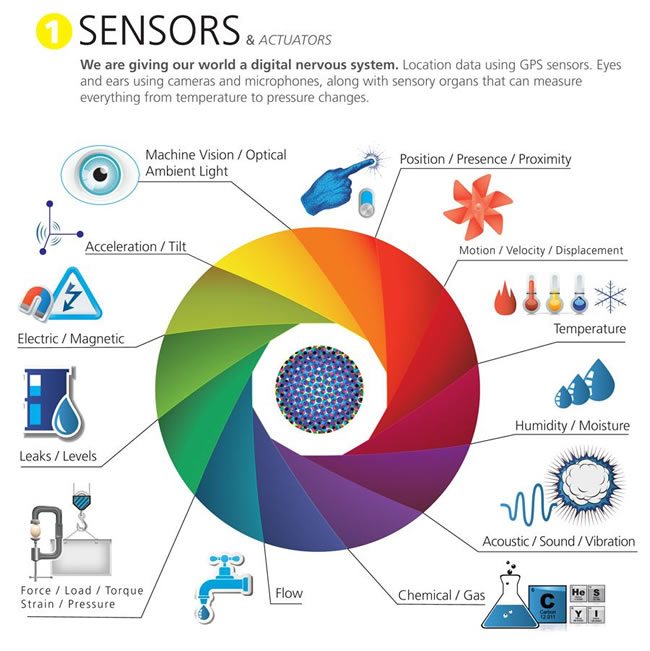
A transducer converts a signal in a form of energy into a signal in another form. In an IoT context, this means that “a sensor is a device that detects, measures or indicates any specific physical quantity such as light, heat, motion, moisture, pressure, or similar entities, by converting them into any other form which is mostly, electrical pulses.”
There are over 100 different types of sensors. They can be bought separately or on so-called sensor boards which have been designed to gather several sensors that are needed in the scope of an IoT use case or project. There are sensor boards for applications such as smart city air quality monitoring and smart traffic applications. There are also sensor boards which you can use to customize to try out IoT applications or to build the precise boards you need for any given application, adding the sensors you want.
IoT devices: actuators
Just like sensors, actuators are transducers. And just like sensors they have been used for quite some time now and certainly since before IoT as a term was coined.
In a sense you could say that an actuator does the opposite of a sensor and it’s at least as crucial, even if today what most companies do is acquiring and analyzing data, far less using data as triggers to make ‘something’ happen in the physical world where quite some value resides and not just in the scope of automation but also in consumer IoT applications.
Let’s make the usage of actuators more tangible from an IoT perspective:
An example was covered in an interview with Martin Feder on building management evolutions and BMS systems in the age of IoT and, simply put, goes like this: actuators sit on your radiator or control airflow in a smart room in a smart home or smart building; sensors detect there is no one in the room; actuators get triggered to lower temperature (or stop HVAC or whatever); control system reports back decision to management system (with energy savings as a result) and everyone happy.
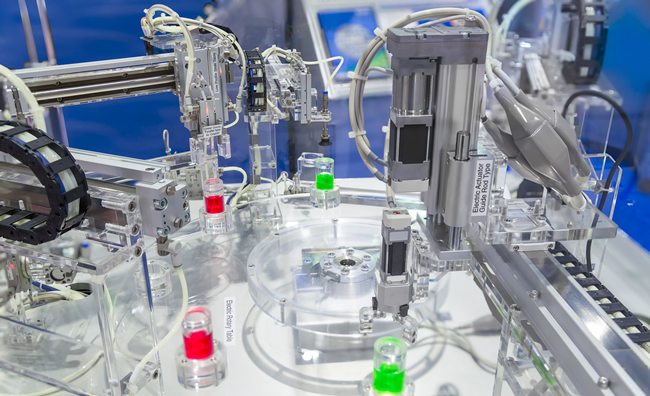
You can imagine many other scenarios in that sense. Meeting room lights, air conditioning and heating are turned off; worker approaches ‘smart office’, looks for available meeting room on his app and books it for meeting; actuators get signals to make sure that the meeting room meets what one expects from a healthy comfortable meeting room.
OK, we make it sound a bit easier than it is. Just as there are many types of sensors there are many types of actuators and ways in which they are used.
Electric actuators can turn their energy in mechanical torque, other actuators can control valves (think combinations with sensors regarding for instance water leaks), and so forth.
In the scope of IoT, actuators in most cases are about turning something on or off by applying some force. However, there are also plenty of applications in industrial applications or robotics such as the usage of actuators for grippers.
IoT gateways: devices on the intersection of devices/data and IoT platforms
In more than one sense IoT gateways can also be ranked under IoT devices. An IoT gateway can be hardware but it can also be software and often a combination of both and, given the increasing functions of IoT gateways it’s best to see them as a separate layer, not in the least because of these functions and the technology aspects.
IoT gateways come in many forms and shapes, precisely because they (can) fulfil (an increasing number of) several tasks. In other words: the usage of IoT gateways is changing, compared with the earlier days of IoT. And that has everything to do with the original scope of an IoT gateway and how the evolutions in IoT lead to more bundling of functions in the gateway which is ideally placed to perform these functions, given its essential function as a bridge, well, gateway.
Essentially an IoT gateway plays a critical role on the intersection of IoT devices in the strict sense (and thus the data from IoT devices) and the network, cloud or data center as explained in our in-depth article on IoT gateways where you can also see there are gateways for the Industrial IoT, gateways for edge computing (also see IoT and edge), gateways for home automation, where they aggregate and orchestrate communications between home sensors and cloud services and much more.
So, this is a broad layer with multiple devices, technologies, solutions (software and hardware) and functions. IoT gateways de facto are used for connectivity aggregation, encryption and decryption of IoT data (cybersecurity), the translation of the various protocols that exist in the overall IoT technology landscape as explained, the management and onboarding of IoT devices, the mentioned IoT edge computing, remote control and management, pre-processing and aggregation of data and so forth.
Simply said: they play a critical role on multiple levels but as the name suggests IoT gateways essentially are just that: they are a gateway between the IoT device level and the technologies and environments where the data from IoT devices really get leveraged.
As there are more IoT devices and thus more IoT data, it’s easy to understand why more functions and goals are packed in IoT gateways. Many sensors with often really many data points mean that pre-processing can be done in the gateway and that gateways and the analysis of data overall is increasingly moving to the edge and edge gateways.
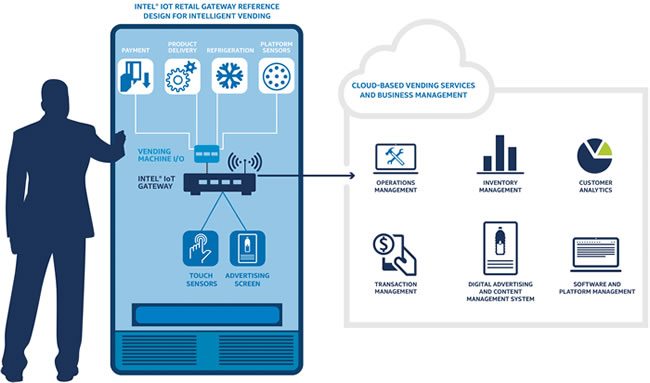
However, as you can read in our article on the impact of IoT data on IT infrastructure most analysis of IoT data still happens in a data center. Hence the broad variety of IoT gateways, from the edge to the network or cloud, whatever people want. In the context of this layer we also must emphasize IoT device management which is key in IoT platforms on the level of M2M features.
IoT technology beyond the gateway: IoT platforms
The third layer of the IoT technology stack consists of IoT platforms. It’s again a broad category of applications with multiple potential features.
With IoT platforms we are in software and, more specifically, a middleware between the more hardware-related layers of IoT devices and IoT gateways on one hand and the business and application layers on the others. However, it isn’t that simple (anymore).
The term IoT platform is widely used but not everyone means the same thing when talking about it. To make things even worse, there are several types of IoT platforms and, of course, given the evolutions we touched upon regarding IoT gateways, you guessed it, here as well additional features are being added. Moreover, in the current IoT platform wars and with over 400 different IoT platforms around there is an ongoing move to specialization and differentiation. And, indeed, no IoT platform is the same.
As we mentioned in an article on the IoT platform market strictly speaking an IoT platform is an IoT Application Enablement Platform. That name pretty much covers what it does. On top of that there are IoT device management platforms (DMPs) whereby IoT device management is virtually always present in IoT platforms overall, analytics platforms and IoT orchestration platforms, to name a few more as you can read in this article on IoT platform testing.
As Nicolas Windpassinger, author of the IoT book Digitize or Die, who also tackles the IoT technology stack, puts it in his book “The different types of IoT platforms have become essential enablers, a means of gathering and making sense of data and delivering the right kinds of services at the right time”.
Exactly: it’s about the business outcomes and services. As Nicolas, who sees IoT platforms as delivering services such as connectivity support, service enablement, device management application support and solution provider services, quoted from an interview he had with Josef Brunner, CEO at relayr, “the big challenge is that IoT platforms are not about technology but are about use cases and user benefits.”
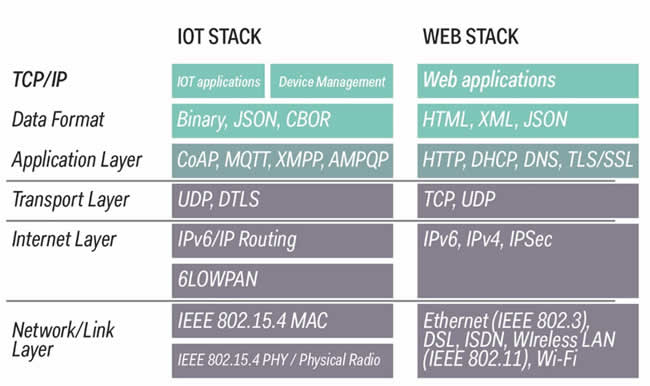
And that seems like a good way to end this first article on the IoT technology stack before moving on to a second one where we look at more IoT technology layers. Below is a more technical view of the IoT stack (with TCP/IP).
Top image: Shutterstock – Copyright: Mikko Lemola – Automatic robot chemical production line picture: Shutterstock – Copyright: FUN FUN PHOTO – All other images are the property of their respective mentioned owners.

